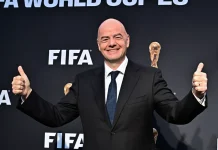FIFA’s announcement that it will implement a dynamic pricing model for ticket sales at the 2026 World Cup—hosted across the U.S., Canada, and Mexico—has sparked intense criticism, with many questioning whether this strategy prioritizes profit over fans. While the organization frames dynamic pricing as a modern, flexible approach, its implications suggest a deeper shift: the monetization of football at the expense of accessibility, transparency, and fairness.
A Revenue Strategy, Not a Fan-Centric Solution
Dynamic pricing—where ticket prices fluctuate in real time based on demand—marks a sharp departure from the traditional fixed-pricing systems that have historically ensured a degree of accessibility in major tournaments. FIFA claims this approach will optimize revenue and enhance market efficiency. But at its core, the model appears designed to extract the maximum possible value from high-demand matches, with little regard for the average supporter.
Ticket prices for premium matches like the opening game and final could climb into the thousands. FIFA Hospitality packages are already priced between $3,500 and $73,200, signaling the organization’s intent to court high-paying corporate and elite customers. This raises a fundamental question: Is FIFA commodifying access to the World Cup to such an extent that loyal fans are being priced out altogether?
Transparency or Obfuscation?
FIFA’s lack of clarity about how dynamic pricing will work only deepens concerns. No public explanation has been offered regarding the algorithmic mechanisms that will determine price fluctuations. Fans are being asked to trust a black-box system that could alter prices dramatically without notice or justification.
Critics like Ticombo—a resale platform that champions transparency in ticketing—argue that this opacity makes it nearly impossible for fans to plan or budget effectively. In their words, fans are being penalized by “unpredictable and obscure pricing models,” leaving them vulnerable to unexpected spikes (Ticombo Statement, 2025). Why hasn’t FIFA been more forthcoming with details? And if this system is meant to benefit consumers, why is it being implemented with so little oversight or explanation?
Accessibility at Risk
The financial barriers for fans attending a World Cup spread across three countries are already substantial. Adding volatile, demand-driven pricing to the mix compounds the problem. FIFA often touts the World Cup as “the world’s game,” celebrating its diversity and global reach. Yet the dynamic pricing model risks transforming the tournament into a playground for the wealthy.
Will the average supporter, particularly those from less affluent nations, be able to afford tickets to high-profile matches? The answer increasingly appears to be no.
Undermining the Secondary Market
The consequences of this pricing strategy extend to the resale market. When original ticket prices are unstable, resale platforms cannot enforce price caps or evaluate fair market value—opening the door to unchecked scalping and speculative markups. Ticombo warns that this will further distort the ticketing ecosystem, creating confusion and inflating prices for fans who miss out on primary sales.
If FIFA truly cared about consumer protection, why introduce a system that actively disrupts market transparency and fosters inequality?
The Need for Oversight and Regulation
The secrecy surrounding FIFA’s pricing algorithms, combined with its relentless pursuit of record-breaking revenue targets ($13 billion projected for the 2023–2026 cycle), raises important regulatory questions. Should a private organization with global influence be allowed to implement opaque pricing mechanisms for a publicly beloved event with no independent oversight?
Fan organizations and resale platforms are now calling for legislation that would require transparency in ticket pricing, cap price increases, and protect consumers from predatory practices. These demands are not just reasonable—they are urgent. Football should not be driven by corporate greed, nor should it be reshaped by algorithms hidden from public scrutiny.
Lessons Ignored?
Events like the 2024 Copa America and the 2025 Club World Cup showed both the potential and the pitfalls of dynamic pricing. While organizers did see increased revenue, many fans reported frustration and confusion over fluctuating ticket costs. Rather than learn from these outcomes, FIFA appears to be doubling down—scaling up a contentious model without addressing the underlying issues of trust and accessibility.
Football for Sale?
FIFA’s dynamic pricing strategy for the 2026 World Cup may boost short-term profits, but at what long-term cost? The organization risks alienating its core audience and undermining the inclusivity that has defined football for generations. By embracing an opaque, demand-driven pricing system, FIFA has opened itself to valid criticism: Has the World Cup become more about revenue than the fans?
Unless FIFA takes meaningful steps to introduce transparency, consult with stakeholders, and ensure equitable access, it may find that its greatest spectacle has become its greatest liability.













